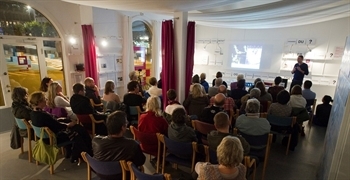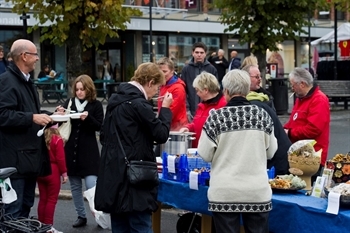
Dream Hamar
Through a series of programmed events, community members realized that their central square could be much more than a parking area.
 By Joanna Mikulska, cultural animator and social and cultural events producer
By Joanna Mikulska, cultural animator and social and cultural events producer - July 8, 2014
This is the third in our four-post "Old Place New Tricks" blog series. We at the Metropolitan Planning Council hear from community groups that want to make their neighborhood more active and inviting, but don’t know where to begin. This year’s Old Place New Tricks Placemaking challenge was designed to help communities work through the process of creating change, drawing from examples in the U.S. and Europe. You can find the rest of the posts here and learn more about the contest here.
Cities across the United States often look to historic European town squares, built as communal gathering spaces before the prioritization of automobiles, for lessons in walkability and vibrant street life. But sometimes even these cities and their once-prominent town squares are in need of revitalization. In Norway, the eastern City of Hamar provides one such example.
Known for its breathtaking fjords, world-class skiing and midnight sun, Norway is rich in amenities. The City of Hamar has historically been an important center of trade for the Hedmark region, and its Stortorget Square was always full of people. Today, Hamar is home to 30,000 people and due to cultural, social and economic shifts, it is no longer the trading hub it once was. Recently the city has struggled to establish a new identity.

Stortorget Square served as a community gathering place prior to the rise of the automobile.
digitalmuseum.no
Dream your city
In pursuit of defining itself in the 21st century, the city of Hamar launched an international competition called “Art on Stortorget” to redesign the historic Stortorget Square, located right in the center of the city. The competition emphasized the importance of a participatory process. The City decided against planning for a new sculpture or monument, as many cities across the world often do. Instead, Ecosistema Urbano, a group of architects in Madrid, implemented a plan that focused on meaningful engagement of the local and international community. “Dream Hamar” was a participation and design process that lasted four months, bringing together local community and international professionals through a series of public workshops where new ideas for the square were generated.
The Hamar community was engaged through a series of workshops and lectures during the initial stages of planning. Each of the five public workshops focused on a single priority for the square: environment, technology, seasonal strategy, activities or people. The goal of each workshop was to brainstorm fresh ideas, establish new partnerships and develop a new vision for Stortorget. Sociologists, designers, urban planners and artists from all over Europe came together to facilitate the workshops and to help participants develop a new vision for the square.

Dream Hamar relied heavily on community involvement, like at this public meeting.
Dream Hamar
In collaboration with Academic Network, the national program The Cultural Rucksack and students from local schools, focused on the development of ideas. There were also placemaking activations that temporarily transformed the space to help the community reimagine it as an active and vibrant place.
Finally, a digital lab provided a space for people from around the world to contribute to the ideas that were being developed and interact with others through online workshops, discussion, web conferences and posts for a dreamhamar blog.

Community members of all ages were encouraged to participate.
Dream Hamar
Participative model of redesign
Like a living organism, “Dream Hamar” grew and evolved as the work progressed. CreamHamar and StoryHamar, provide insight into how the process worked and its rewards.
After living in Hamar for just a few short months, I came to learn about the DreamHamar project when I stumbled upon pink hoof prints that had been painted on nearby sidewalks. The prints created a path leading to the square where students from the Bergen School of Architecture were providing a free lunch to visitors. The menu included fresh milk for coffee, provided by a cow located on site. Everyone was welcome to join in for the unusual meal
To help participants reimagine the possibilities for Stortorget Square, in advance of the event, cars were removed and the square was returned to pedestrians. Tables, chairs and stalls with local food dotted the space; a local farmer supplied the cow. The square was alive again with people interacting—sitting, eating and chatting. They had come to see what an active and engaging place Stortorget Square could be and provide additional input for future programming and activation.

Events on the square helped the community realize that they could do more than park cars there.
Dream Hamar
After the CreamHamar event, the local community was invited to take part in workshops around topic of “people.” The most important part was our “emotional mapping” exercise, which underscored the emotional value the local community placed on Stortorget Square and suggested an opportunity to incorporate this attachment into the activations. In my opinion it was a valuable contribution to redesigning the square and inspiration to organize workshops about Stortorget—this led to the next activation, StoryHamar.
StoryHamar was a workshop for older citizens of Hamar during which participants shared stories and photos about the private history of the square. The powerful histories revealed details about Hamar’s agricultural history and the people that gathered in the market space in the past. StoryHamar encapsulates and celebrates the stories of Stortorget Square while contributing to a new vision for the future.
By bringing the community together through an intensive participatory process and activations that celebrate both the history of the place and future opportunities, the Hamar community was able to attract participation from well beyond the typical attendance at a public meeting. The most important impact of the process was not the final project but the empowerment of the local community to recognize that together, they have the capacity to create something great for their city. Participative urban planning creates the framework for authentic and meaningful community engagement. Once the Hamar community was convinced that the process was worthwhile, it was able to create a new vision for itself.
If you are interested in how you can dream YOUR city, please check it out here. Good luck!
Joanna Mikulska studies theory of culture. She is a journalist, culture animator and producer of social and cultural events. She is keen on history, and interested in the influence of people and their history on architecture and urban planning. She works as a coordinator in the Polish Association of Creative Initiatives “e”, ngo, realizing socio-cultural project all over Poland. Before that she worked as a coordinator of a long-term project about the history of Warsaw, “Roots of Siekierki,” building a local history archive, organizing exhibitions and public events.